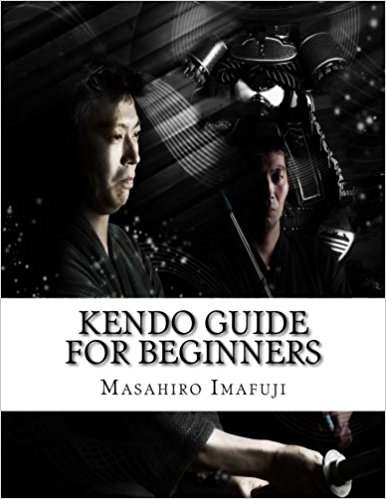You Got It!
Kote Men Strike:
Basic Kote Men Strike in Suburi
This is the basic kote men strike. Kote Men strike is used in kendo all the time and very common technique out of nidan waza (two consecutive striking techniques).
I learned the this strike as Kote OYOBI Men. Oyobi means "and" in Japanese.
When my sensei told me to do Kote Oyobi Men, I knew he meant the basic Kote Men strike. When my sensei said, "kote men", then I knew I had to do small and fast kote and men strike.
But you do not have to use OYOBI, if it is too hard to say. You can say "big kote and men strike" for the basic kote men strike. And you can say "small kote men" for small and fast kote men strike.
Once you have learned Niho Zenshin Niho Kotai, this is fairly easy. All you have to do is to change the first strike from men to kote.
The difficult part, however, is that we have to combine two different strikes together and do it correctly. To do this correctly, we have to;
- bring our sword up to the appropriate height and
- do the right footwork without messing it up.
If you have acquired Niho Zenshin Niho Kotai Shomen Uchi properly, this should be easier to learn.
This is how kote oyobi men uchi is done.
Kote Oyobi Men Uchi
- While lifting our sword up as high as we can see the right kote of our opponent, we take a step forwards onto the right foot. Just like we did in kyodo kote. This step should be smaller than the one when striking a men
- As you strike kote, snap up the left foot forwards. Make sure that the left foot does not pass the right foot or get too close to the right foot.
- Without going back to chudan (i.e. from the kote position), lift our sword up above our head and take a big step forwards onto the right foot.
- As you strike men, snap up the left foot forwards. Make sure that the left foot does not pass the right foot or get too close to the right foot.
- Now we are going backwards. While lifting our sword up as high as we can see the right kote of our opponent, take a step backwards onto the left foot.
- While striking kote, snap the right foot backward.
- As lifting our sword up above our head and take another step backwards onto the left foot.
- While striking men, snap the right foot backward.
We keep doing 1. to 8. until we hear "Yame!".
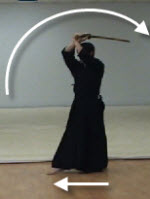 1. Sword up when stepping forwards
1. Sword up when stepping forwards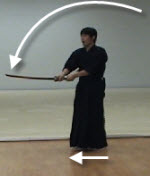 2. Strike Kote when left foot comes forwards
2. Strike Kote when left foot comes forwards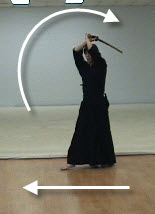 3. Sword up when stepping forwards
3. Sword up when stepping forwards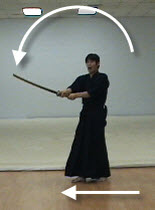 4. Strike Men when left foot comes forwards
4. Strike Men when left foot comes forwards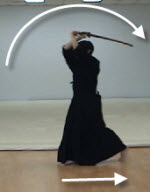 5. Sword up when stepping backwards
5. Sword up when stepping backwards 6. Strike Kote when left foot comes forwards
6. Strike Kote when left foot comes forwards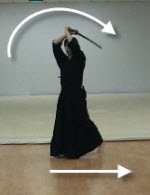 7. Sword up when stepping backwards
7. Sword up when stepping backwards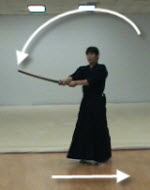 8. Strike Men when left foot comes forwards
8. Strike Men when left foot comes forwardsCOMMAND
- Kote Oyobi Men. Hajime!
- Ichi, Ni, San, Shi, Go, Roku, Shichi, Hachi, Kyu, Jyu
- Yame!
Repeat the count from 1 to 10 as many times as you want. Then, command "Yame!"
KIAI
1. On each count, the practitioners strike kote and men. So they shout, "Kote, men! "
So it is done as shown below.
Commander: Ichi
Practitioners: Kote, men! (going forwards)
Commander: Ni
Practitioners: Kote, men (going backwards)
Commander: San
Practitioners: Kote, men (going forwards)
.
.
Commander: Jyu (going backwards)
Practitioners: Kote, men
Commander: Ichi (going forwards)
Practitioners: Kote, men
and continue until
Commander: Yame!
Some Important Points
Make sure that you do not bring your hands above your head when you strike kote. That is not a big kote strike. Big kote strike is not as big as big men strike. Please refer to kote uchi for more information.
Footwork
I cannot say enough of this...
No toes up while moving and
The left foot stays behind the right foot.
Some points you must pay attention:
- For kote strike, take a smaller step forward.
- Take a big step forward onto the right foot when striking men.
- When striking kote, make sure that you are striking your opponent kote. People tend to strike a higher place than the actual kote height.
Kendo Guide for Beginners Available at Your Amazon
A Kendo Instruction Book Written By A Japanese For Non-Japanese Speakers Who Are Enthusiastic to Learn Kendo.
All the instructions of the basics on this site is in this book with
- New and Better Photos (taken for this book!) and
- Newly Edited Contents
- Corresponding Videos
Kindle version is available too. Click here to learn more about the book.
